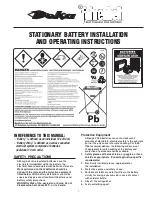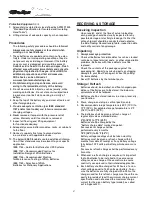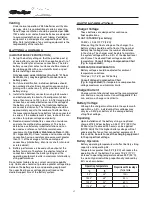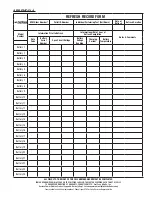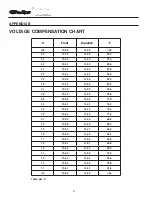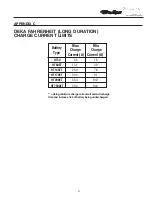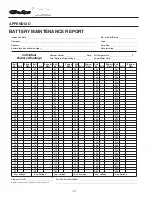
6
®
6
®
MAINTENANCE
Always wear eye protection when working on or near
batteries. Keep sparks and open flames away from
batteries at all times.
Review “Safety Precautions”
(Pg. 1).
Annual Inspection
(1)
1. Conduct a visual inspection of each battery.
2. Record the battery string voltage at battery terminals
while battery is on float charge.
3. Record the charger voltage at charger panel meter.
4. Record the individual battery voltages. The accuracy
of the DMM (Digital Multimeter) must be 0.05% (on
dc scale) or better. The DMM must be calibrated to
NIST traceable standards. Because float readings are
affected by discharge and recharges, these readings
must be taken when the battery string has been on
continuous, uninterrupted float for at least one month.
Battery should be within ± 0.30 volts of the average
battery string voltage.
5. Record the ambient temperatures.
6. Record the battery string temperature at the
negative terminal.
7. Record individual battery Ohmic readings.
8. Record all interbattery and terminal connection
resistances. Micro-ohm readings should be taken
during this inspection. If any reading differs by more
than 20% from initial readings taken, retorque the
connection. Retourque value is equal to initial torque
value as indicated in BATTERY ASSEMBLY section.
Recheck the micro-ohm reading. If the reading
remains high, clean the contact surface according to
installation portion of this manual.
(1)
Other Maintenance Inspection intervals follow
IEEE 1188
Battery Cleaning
Do not use any chemical compounds to clean bat-
teries. Batteries, cabinets, and racks, shall only be
cleaned with: clear water, a mixture of baking soda
and water or East Penn Mfg battery cleaner (part #
00321).
Any other types of chemical compounds or
solvents other than listed above, to clean the
battery may damage the battery case and / or
cover causing possible exposure to sulfuric acid.
Capacity Testing
Per IEEE 1188 “Capacity testing is used to trend
battery aging. The result of a capacity test is a
calculation of the capacity of the battery. The cal-
culated capacity is also used to determine if the
battery requires replacement.”
When performing capacity testing and recording data
refer to IEEE 1188 recommendations.
NOTE: When discharging at higher rates, extra
connectors may need to be added to prevent exces-
sive voltage drop and/or excessive temperature rise.
Should it be determined that only individual bat-
tery(ies) need to be replaced, contact East Penn.
Содержание fahrenheit
Страница 11: ...P a g e I n t e n t i o n a l l y B l a n k ...

